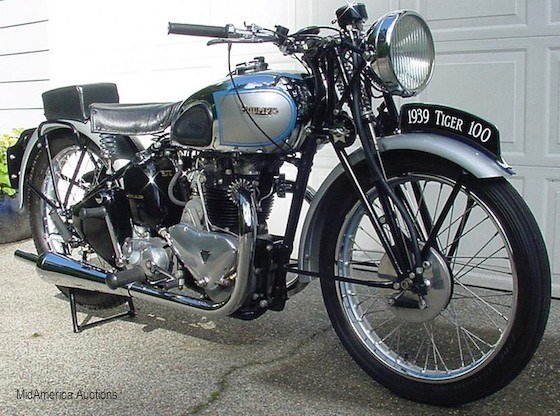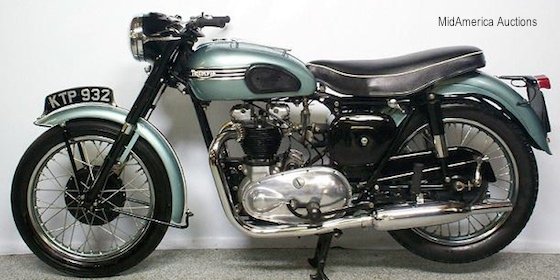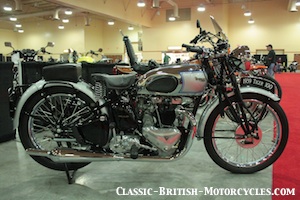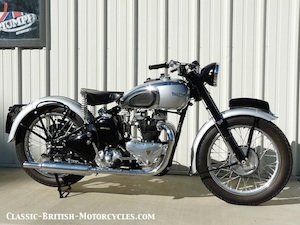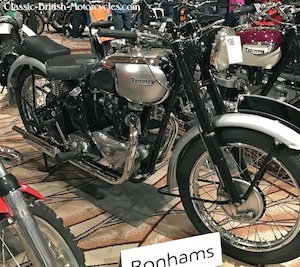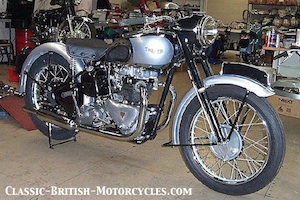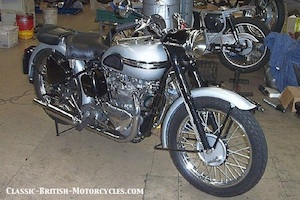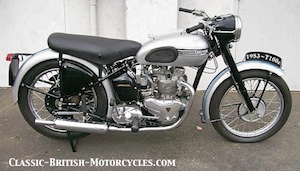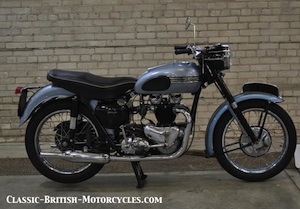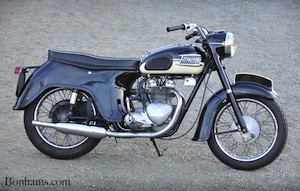1939 Triumph Tiger 100, first year for this hot new model. Note Rigid frame & girder front suspension.
A TIGER IS BORN
The Triumph Tiger was the natural evolution of the constant & relentless quest for more & more power. The <a href=”https://www.classic-british-motorcycles.com/triumph-speed-twin.html”>Triumph Speed Twin</a> had literally changed the motorcycle world in 1938, and was head-and-shoulders above just about everything else on the market, and the performance leader. But even that wasn’t enough. By 1939, Edward Turner, designer of the Speed Twin & defacto father of every vertical twin that came after, raised the compression ratio from 7.2:1 in the Speed Twin to 8.0:1 for the new Triumph Tiger 100, along with a ported cylinder head. The name implied that the new bike would top 100 mph, and indeed this was the case. These early bikes came with rigid frames & girder front ends. The new 1939 Tiger 100 came in silver with black pinstriping, set apart from the stodgy dark red of the Speed Twins. The Triumph Tiger became the fastest bike on the market overnight & Triumph had its second major hit in 2 years. Life was good for Triumph Motorcycles, then World War 2 intervened & all civilian production ceased to make was for war production.
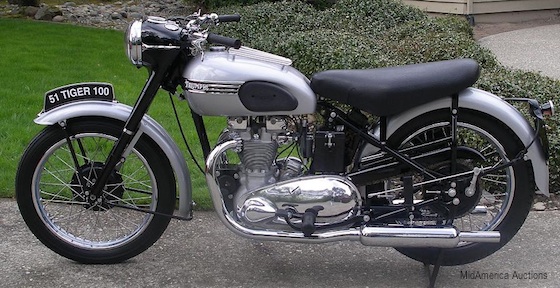
1951 Triumph T100 Tiger. Still has a rigid frame but now has telescopic front forks.
POSTWAR BOOM
Triumph Motorcycles wasted no time getting back to business, after the cessation of hostilities. Their factory has been destroyed by German bombers in 1942 & a new factory had been built from the ground up. Edward Turner, now General Manager of Triumph Motorcycles, planned to focus production exclusively on twin-cylinder machines (his babies). Shortages of raw materials were rampant in England after the war, everything from steel, to rubber to electricity being in short supply. Priority was given to companies who were exporting products overseas & Turner rightly reasoned that the twins had the biggest export market. Single cylinders were dropped from the lineup & the twin flourished. In 1946 civilian production resumed & immediately Triumph 6T Speed Twins and its hotter sibling, the Triumph T100 Tiger, began rolling off the assemblyline. The 1946 Triumph T100 Tiger was a 500cc vertical twin with a single carburetor & a rigid frame, but the girder front end had been upgraded to telescopic forks.
1955 Triumph T110 Tiger 650. Swingarm rear suspension started in ’54.
TWO TIGERS FIGHT SIDE-BY-SIDE
By 1950, even the hottest 500 Tiger twin wasn’t fast enough. Edward Turner bored & stroked the 500 out to 649cc & the 6T Triumph Thunderbird was born. By this time, there were two Tigers, the T100 & the T100C, both 500 twins. In 1954, they introduced a second Tiger, this one a 650, called the T110 Tiger, or Tiger 110, with the same inferred claim to 110mph top speed. So now, and for the balance of the pre-unit years (ending in 1958 for the 500 & 1962 for the 650), one could own a Triumph Tiger that was either a 500 (T100 & T100C) or a 650 (T110).

1960 Triumph T110 Tiger, shows the short-lived “Bathtub” styling.
BATHTUB STYLING FAD
In the late-1950s, a styling trend was prevalent among British Motorcycle Manufacturers toward enclosing and streamlining their machines. The Velocette Vogue and Vincent Black Prince are examples of this and their aim was clearly to make life easier for English riders who had to contend with inclement weather. Triumph was soon to follow suit. The <a href=”https://www.classic-british-motorcycles.com/triumph-thunderbird.html”>Triumph Thunderbird</a> and the Triumph Tiger 100 and Tiger 110 already had fully-valanced fenders & a headlight nacelle, but this was taken further still by enclosing the entire rear section of the frame, from the engine back. This large sheetmetal “bathtub” encapsulated the oil tank, battery tray, tool box & rear fender all in one bulbous, unattractive mass. The 6T Thunderbird sported Bathbub styling from 1960 through 1962, but the 650 Tiger T110 ceased production in 1961, so Bathtub Tigers ran 1960-61.
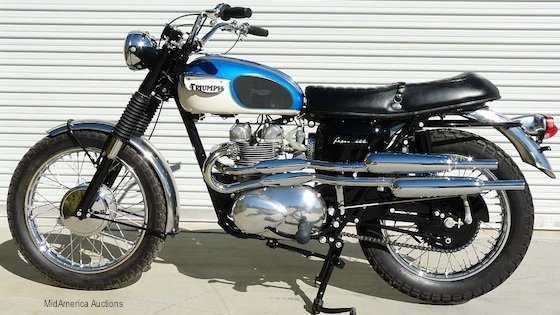
1967 Triumph T100C Tiger 500 with high pipes.
UNIT CONSTRUCTION CHANGES EVERYTHING
Triumph was in the process of unitizing all it’s engines. Instead of a separate engine, primary chaincase & gearbox all bolted together with heavy steel plates in the frame, all 3 component sets were now placed into one common set of cases, into one unit, ie: “unit construction”. The 500 twin had gone ‘unit’ in 1959 and in 1963, the 650 would follow. This had an effect on the Tiger line, which was made up of both pre-unit 500s and 650s. The T100 & T100C Tigers (500 twins) continued only until the new unit construction 500s took over in 1960 with the T100A Tiger 100, followed by a litany of Tiger 500s. There would be no unit-construction 650 Tigers until the Oil-in-Frame 1971 Triumph TR6R Tiger.
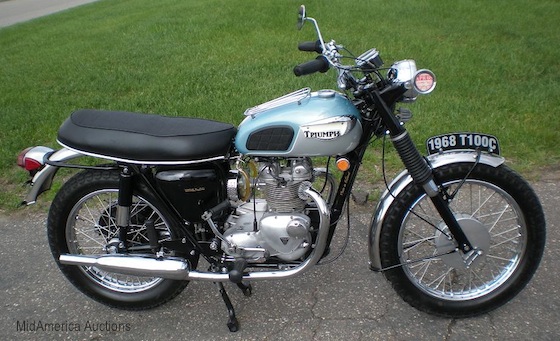
1968 Triumph T100S Tiger 500, with downpipes.
TIGER 500s THUNDER THRU THE 60’s
The 650 was dropped from the Triumph Tiger lineup just prior to it going ‘unit’ for the 1963 model year. The last 650 Tiger was the 1961 Triumph T110 Tiger 110. Through the 1960’s the 650 lineup would include the Triumph Bonneville, the TR6 & for a few more years, the frumpy Thunderbird. Instead all 1960’s Triumph Tigers from here on would be 500s, except for a new, smaller Tiger, the T90 Tiger 90, which was based on the 350cc 3T twin, which ran from 1963 through 1969. The 500 Tigers went by several different model designations during this period, T100, T100S & T100SS.
A 1973 Triumph TR7RV Tiger, the first of the 750 Tigers.
OIL-IN-FRAME TIGERS
The 1960’s ended at the same time the Britain’s domination of the motorcycle market ended. While the 1970 Triumph Motorcycles were fast, stylish & sold well, the emergence of Honda as a major player in the heavyweight class was a bad omen. The new Honda 750 Four had stunned the world with its value & sophistication, something that even the wickedly-cool 3-cylinder Triumph Trident couldn’t do & the entire British motorcycle industry had nothing in the pipeline that could match it.
HOW THE MIGHT FALL
They would have been in trouble anyway, even if it hadn’t been for all the poor planning, underhanded dealings, mismanagement & general lack of funds. But indeed all these things made a bad situation much worse. BSA, once one of the largest multinational corporations in the world & THE largest producer of motorcycles as recently as 1960, was now practically on death’s door and taking Triumph Motorcycles (which it owned) with it. But not before they screwed things up good, which was, by this time, standard operating procedure at BSA.
TURNING MISMANAGEMENT INTO AN ARTFORM
Their overpriced & grossly incompetent tech center, Umberslade Hall, had come up with the brilliant idea of solving the 650 twins’ myriad problems with a new frame which carried the oil internally within the backbone of the frame itself, rather than in a separate oil tank. This was something no one asked for or wanted. Many more urgent problems needed to be addressed in the 650: Vibration, oil leaks, dodgy electrics & overall spotty build quality, not to mention a burning need for a 5-speed, an electric starter & a disk brake to match Honda. To make matters worse, they didn’t even do a good job of it. The new oil bearing frame was too tall (with a seat height of over 34 inches), most of the oil capacity in the frame couldn’t be used leaving it woefully short on oil capacity & the engine couldn’t be installed in the frame without partially disassembling it. All these problems delayed release until late in 1971. With it, the Tiger ceased being based on the 500 twins and from them on would be based on the 650 and 750 twins with oil-bearing frames.
Triumph Tiger MODEL DESIGNATIONS
1939…………………..T100 Tiger 100 (500 pre-unit twin)
1946-58……………..T100 Tiger 100 (500 pre-unit twin)
1949-58……………..T100C Tiger 100 (500 pre-unit twin)
1954-61……………..T110 Tiger 110 (650 pre-unit twin)
1960-61……………..T100A Tiger 100 (500 unit twin)
1962-65……………..T100SS Tiger 100 (500 unit twin)
1963-69……………..T90 Tiger 90 (350 unit twin)
1966…………………..T100 Tiger 100 (500 unit twin)
1967-70……………..T100S Tiger 100 (500 unit twin)
1971-73……………..TR6R Tiger 650 (650 unit twin)
1972-73……………..TR6RV Tiger 650 (650 5-speed)
1973-83……………..TR7RV Tiger 750 (750 5-speed)
1981-82……………..TR6T Tiger Trail 650 (650 enduro)
1981-82……………..TR7T Tiger Trail 750 (750 enduro)
Triumph Tiger YEAR-BY-YEAR
This pre-war 500 twin was the hottest thing on the road in 1939. A pumped up version of the pedestrian Speed Twin, it offered performance unheard of in this price-range.
Early post-war 500 twin. Lower compression to cope with the lousy gas in the UK at the time. Iron heads, rigid frame.
The Triumph Tiger returns relatively unchanged, as Triumph’s top-performer.
This is the last year before the arrival of the 650 Thunderbird. Until then, the 500 Tiger is one of the fastest bikes on the road!
Triumph’s 500 parallel twin sets the pace for high performance street bikes in 1950, that it until the arrival of its bigger brother, the 650 Thunderbird.
Triumph’s slick 500cc Roadster was fast, one of the fastest of its day. It quickly gained a reputation on the street & was an immediate hit.
Triumph’s all-aluminum 500cc twin continues to be refined. It is a stellar performer in its day, one of the fastest bikes on the market at that time.
The T110 Tiger was Triumph’s hottest & one of the fastest bikes on the street…until the TR6 came along in ’56.
The 650 Tiger is one of the fastest bikes on the market in 1958, soon to be eclipsed by the twin-carb Bonneville in ’59.
The 500cc T100 had full bodywork earning it the nickname “Bathtub”.
Check out these TRIUMPH BOOKS
Triumph Motorcycles: The art of the motorcycle
The Complete Book of Classic and Modern Triumph Motorcycles 1937-Today (Complete Book Series)
Triumph Motorcycles: From Speed-Twin to Bonneville
Triumph Bonneville and TR6 Motorcycle Restoration Guide: 1956-83
British Motorcycles Triumph (Little Books)
Triumph Motorcycles in America
McQueen’s Motorcycles: Racing and Riding with the King of Cool
Triumph Motorcycle Restoration
Illustrated Triumph Motorcycles Buyer’s Guide: From 1945 Through the Latest Models (Illustrated Buyer’s Guide)
Tales of Triumph Motorcycles and the Meriden Factory
Hinckley Triumphs: The First Generation (Crowood Motoclassic)


